|
|
Butterflies - Whites & Sulphurs -
More Information
|
|
|
~ Click on any image for an enlargement - scrollable if it is too big for browser window ~
|
|
Kingdom: Animalia
Phylum: Arthropoda
Subphylum: Hexapoda
Class: Insecta Pterygota
Order: Lepidoptera
Superfamily: Papilionoidea
Family: Whites and Sulphurs Pieridae
Subfamilies: Sulphurs Coliadinae - Whites Pierinae
Family Description: The Pieridae are members of the Superfamily Papilionoidea, the true butterflies. Worldwide in distribution, most species are found in the tropics. Adults have medium to small wings that are white, yellow, or orange, with some black or red, and many have hidden ultraviolet patterns that are used in courtship. Species with more than one generation usually have distinct seasonal variation in appearance. Adults of all species visit flowers for nectar, and adults of both sexes have three pairs of walking legs. Males patrol in search of receptive mates, and females lay columnar eggs on leaves, buds, and stems. The majority of caterpillars of North American whites and sulphurs feed on legumes or crucifers (members of the Mustard family). Typically, temperate species overwinter in the pupal or larval stage, while tropical species overwinter as adults.
Subfamily Description: Sulphurs are members of the Family Pieridae. In North America, sulphurs range from Mexico to northern Canada. Females of most species are distinctly different from males. Some species are mud-puddlers and will collect around muddy pools on dirt roads. Sulphurs overwinter as larvae.
Subfamily Description: Whites, marbles, and orangetips are members of the Family Pieridae. In North America, 31 species are included. Adults of most species are predominantly white above with some black pattern elements, and their hindwings often have a pattern of yellow and black scales that appear green. Sexes of most species are only slightly dimorphic, though male orangetips have bright orange wingtips. Nearly all adults are avid flower visitors. The males of almost all North American species patrol open, sunny habitats for females, although males of some tropical whites (e.g. Mexican Dartwhite) perch along ravines. Caterpillars of most western whites feed on mustards, though some use capers and others, pineneedles. All species overwinter in the chrysalis stage, and some orangetips and marbles may pass several unfavorable years in the chrysalis stage before hatching.
|
Clouded Sulphur
Cloudless Sulphur
Dainty Sulphur |
Falcate Orangetip
Little Yellow
Lyside Sulphur |
Orange Sulphur
Sleepy Orange
Southern Dogface |
Clouded Sulphur Butterfly
Subfamily: Coliadinae
Colias philodice
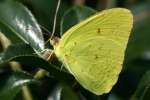 |
- Identification: Upper surface of male wings bright, clear yellow with solid black edging; lower side of forewing with some dark submarginal spots; hindwing with silver cell spot rimmed with orange-pink, usually doubled. Female has 2 forms: yellow form with uneven black edging enclosing yellow spots, and a white form which is greenish-white rather than yellow. Spring and fall forms are smaller and less conspicuously marked.
- Life history: Eggs laid singly on host; caterpillars eat leaves. Hibernation is by third-stage caterpillars.
- Flight: Three flights in the north from May-October, 4-5 in the south from March-November.
- Wing span: 1 1/2 - 2 3/4 inches (3.8 - 7 cm).
- Caterpillar hosts: Plants in the pea family (Fabaceae) including alfalfa (Medicago sativa), white clover (Trifolium repens), and pea (Pisum sativum).
- Adult food: Flower nectar of many plants.
- Habitat: Many different open areas including fields, lawns, alfalfa and clover fields, road edges, meadows.
- Range: Alaska south through central and southeast Canada, all of conterminous United states except much of California, south Texas, and most of Florida.

|
|
Cloudless Sulphur Butterfly
Subfamily: Coliadinae
Phoebis sennae
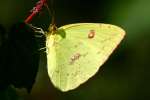
|
- Identification: Upper surface of male is lemon yellow with no markings. Female is yellow or white; outer edges of both wings with irregular black borders; upper forewing with dark spot in cell. Lower surface of hindwing of both sexes with 2 pink-edged silver spots.
- Life history: Males patrol with rapid flight, searching for receptive females. Eggs are laid singly on young leaves or flower buds of host plants; caterpillars eat leaves and rest on underside of leaf petioles.
- Flight: Many flights year around in the Deep South; may have one flight in late summer in other southern states; immigrants to northern states in August or September usually do not reproduce.
- Wing span: 2 1/4 - 3 1/8 inches (5.7 - 8 cm).
- Caterpillar hosts: Cassia species in the pea family (Fabaceae).
- Adult food: Nectar from many different flowers with long tubes including cordia, bougainvilla, cardinal flower, hibiscus, lantana, and wild morning glory.
- Habitat: Disturbed open areas including parks, yards, gardens, beaches, road edges, abandoned fields, scrub.
- Range: Permanent resident from Argentina north to southern Texas and the Deep South. Regular visitor and occasional colonist in most of the eastern United States and the Southwest.

|
Dainty Sulphur Butterfly
Subfamily: Coliadinae
Nathalis iole
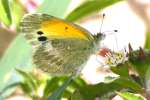 |
- Identification: Small, with elongated forewings. Upperside yellow with black markings, female with more extensive black than male. White form very rare. Underside of forewing with orange or yellow patch at base of wing and black spots at outer wing edge. Winter form has dusty green hindwing, summer form hindwing is pale yellow.
- Life history: Males patrol a few inches above the ground in low areas for females. Females lay eggs singly on leaves of host plant seedlings. Adults rest with wings closed and held perpendicular to the sun's rays to warm themselves.
- Flight: Throughout the year in peninsular Florida and South Texas. After overwintering as adults in the South, some migrate north in spring and summer. Flight of about 6 months in the north.
- Wing span: 3/4 - 1 1/4 inches (2 - 3.2 cm).
- Caterpillar hosts: Low-growing plants in the aster family (Asteraceae) especially shepherd's needle (Bidens pilosa), sneezeweed (Helenium), fetid marigold (Dyssodia), and cultivated marigold (Tagetes).
- Adult food: Nectars at Labrador tea, asters, wild marigold, rabbitbrush, and others.
- Habitat: Open, dry places including coastal flats, weedy fields, grasslands, road edges, meadows, and hillsides.
- Range: Resident in Guatemala north to peninsular Florida and the Southwest. Cannot survive cold winters, therefore every summer re-colonizes through the Great Plains to southeast Washington, southeast Idaho, Wyoming, and Minnesota.

|
|
Falcate Orangetip Butterfly
Subfamily: Pierinae
Anthocharis midea
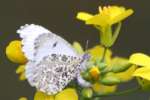
|
- Identification: Upperside of male forewing with orange, hooked tip; females hooked, but lack orange; both have round black spot in cell. Underside of hindwing has finely-patterned green marbling.
- Life history: Males patrol for females. Only one egg is laid per host plant, singly on a flower stalk. Caterpillars feed on buds, flowers, and seed pods. Chrysalids hibernate.
- Flight: One flight from March-June.
- Wing span: 1 3/8 - 1 3/4 inches (3.5 - 4.5 cm).
- Caterpillar hosts: Plants of the mustard (Brassicaceae) family including rock cress (Arabis) and winter cress (Barbarea) species.
- Adult food: Flower nectar including flowers of mustards, violets, and others.
- Habitat: Open, wet woods along waterways, open swamps, occasionally dry woods and ridgetops.
- Range: Southern New England southwest to south Texas, north to eastern Oklahoma and Kansas. Local populations or strays to Florida panhandle, eastern Nebraska, and southern Wisconsin.

|
|
Little Yellow Butterfly
Subfamily: Coliadinae
Eurema lisa
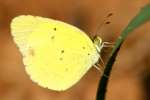
|
- Identification: Upperside of male forewing yellow with wide black apex. Hindwing with black border. Female yellow or white (rare) with black borders. Both sexes with small black spot in forewing cell.
- Life history: Males patrol for females during warm daylight hours. Females lay eggs singly on midveins or between leaflets of host plant leaves.
- Flight: Four-five flights in South Texas and the Deep South; 1-3 flights in northern part of range, from late spring to early fall.
- Wing span: 1 1/4 - 1 3/4 inches (3.2 - 4.4 cm).
- Caterpillar hosts: Partridge pea (Cassia fasciculata) and wild sensitive plant (C. nicitans) in the pea family (Fabaceae).
- Adult food: Nectar from flowers in the aster family (Asteraceae) including goldenrods and asters.
- Habitat: Dry, open areas including roadsides, sandy fields, abandoned fields, along railroad tracks, and occasionally open woods.
- Range: Resident in Costa Rica north to South Texas and the Deep South; seasonally colonizes most of eastern United States and west to eastern South Dakota, central Nebraska, and eastern New Mexico.

|
|
Lyside Sulphur Butterfly
Subfamily: Coliadinae
Kricogonia lyside
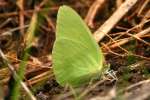
|
- Identification: Tip of forewing square-shaped. Upperside forewing of male white with yellow basal area; often with vertical black bar at wing edge. Underside of hindwing has raised veins and satin sheen. Females occur in both yellow and white forms. Both sexes are extremely variable.
- Life history: Caterpillars hide in bark crevices during the day, and come out to feed at night. Adults periodically make huge migrations.
- Flight: Throughout the year in South Texas, April-August in Florida and to the north and east.
- Wing span: 1 1/2 - 2 3/8 inches (3.8 - 6 cm).
- Caterpillar hosts: Plants in the Zygophyllaceae family vitae (Guaiacum sanctum) in southern Florida and Porliera angustifolia in Texas.
- Adult food: Flowers of black mangrove and shepherd\'s needle have been used as nectar sources in southern Florida.
- Habitat: Tropical scrub lowlands and seasonally dry forests.
- Range: Venezuela north to southern Texas, where it occurs in great numbers. Rare in southern Florida; strays to Colorado, Nebraska, Kentucky, and other states.

|
Orange Sulphur Butterfly
Subfamily: Coliadinae
Colias eurytheme
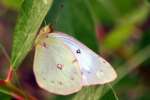 |
- Identification: Quite variable. Upperside of male yellow with orange overlay, yellow veins, wide black border, and dark black cell spot. Female yellow or white with irregular black border surrounding light spots. Underside hindwing spot silver with 2 concentric dark rings, and a spot above it.
- Life history: Males patrol for receptive females, who lay eggs singly on top of host plant leaves. Most feeding takes place at night. Young caterpillars chew holes in the tops of leaves, then later feed from the leaf tip. Older caterpillars eat half of the leaf before moving to the other half. Chrysalids overwinter.
- Flight: Two-three flights in the north from June-October, 4-5 in the south from March-November.
- Wing span: 1 3/8 - 2 3/4 inches (3.5 - 7 cm).
- Caterpillar hosts: Plants in the pea family (Fabaceae) including alfalfa (Medicago sativa), white clover (Trifolium repens), and white sweet clover (Melilotus alba).
- Adult food: Nectar from many kinds of flowers including dandelion, milkweeds, goldenrods, and asters.
- Habitat: A wide variety of open sites, especially clover and alfalfa fields, mowed fields, vacant lots, meadows, road edges.
- Range: Southern Canada to central Mexico, coast to coast in the United States except for the Florida peninsula. Comments: One of the most widespread and common butterflies in North America.

|
Sleepy Orange Butterfly
Subfamily: Coliadinae
Eurema nicippe
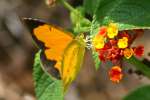 |
- Identification: Upperside of wings orange in both sexes; orange-yellow form rare. Forewing with small black cell spot. Male with sharply defined black borders on outer and costal margins; female borders not so well-defined. In winter form, underside of hindwing is brick red, brown, or tan; in summer form it is orange-yellow.
- Life history: Males patrol flats and gullies for females. Females lay eggs singly under host plant leaves. Caterpillars eat leaves. Dry season form overwinters and lays eggs in spring.
- Flight: Four-five flights, all year long, in southern Texas and Deep South. Mid- to late summer in the north.
- Wing span: 1 3/8 - 2 1/4 inches (3.5 - 5.7 cm).
- Caterpillar hosts: Cassia species in the pea family (Fabaceae).
- Adult food: Nectar from many species of flowers, including shepherd's needle (Bidens pilosa).
- Habitat: Low elevation areas including pine flats, fields, desert scrub, gardens, vacant lots, road edges, and washes.
- Range: Central America north to along the United States-Mexico border; vagrant to non-mountainous parts of the eastern U. S. south of 40 latitude; rare stray to Ontario, Connecticut, South Dakota, and Colorado.

|
|
Southern Dogface
Subfamily: Coliadinae
Colias cesonia
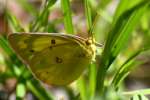
|
- Identification: Upperside forewings of both sexes have yellow "dog's head" surrounded by black. "Eye" does not touch black border. Female similar, with duller, more diffuse black areas and 2 seasonal forms: underside hindwing of wet season "summer" form is yellow; that of dry season "winter" form is mottled with black and pink.
- Life history: Males patrol open areas for females. Eggs are laid on the undersides of terminal leaves of host plants. Adults overwinter in reproductive arrest.
- Flight: Three flights in the southern states from May-June, July-August, and September-April. Northern colonists have one generation per year, or do not reproduce at all.
- Wing span: 2 1/8 - 3 inches (5.4 - 7.6 cm).
- Caterpillar hosts: Small-leaved plants in the pea family (Fabaceae) including alfalfa (Medicago sativa); prairie clovers (Pentalostemon), indigo (Dalea), and clover (Trifolium) species.
- Adult food: Nectar from flowers including alfalfa, coreopsis, houstonia, and verbena.
- Habitat: Dry, open areas such as short-grass prairie hills, scrub oak groves, open woodland, washes, road edges.
- Range: Resident in South America north to southern Texas and peninsular Florida. Stray or temporary resident from central California northeast through the Great Lakes area and all the eastern states.

|
| Information / Identification Sources: |
For identification our primary reference is Butterflies of North America - Kaufman Focus Guides - by Jim P. Brock & Ken Kaufman. We also use internet sources when in question - typically BugGuide and Jeff's Butterfly Page. Our text information (above) comes from Butterflies & Moths of North America. |
|


